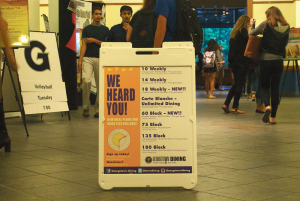
Leo’s advertises changes to its meal plans and Flex dollars for the fall 2014 semester on the first floor of the dining hall.
O’Donovan’s Hall limited its lowest and least expensive meal plan options this year, among other dining changes including adding two new meal plans, barring freshmen from purchasing the 10-meal-a-week plan and altering how Flex dollars can be used on campus.
The two new meal plans include a default 18-meal-per-week plan that comes with 220 Flex dollars and a 60-meal block plan that includes 60 Flex dollars. These plans replaced the 24-meal-per-week plan and 45-meal block plan, respectively.
The 45-meal block plan, previously the lowest option for a semester-based meal plan, used to cost $641. The 60-meal block plan, now the lowest offering, costs $885 per semester.
The limited 10-meal-per-week plan costs $1,958 per semester. The closest option available to freshmen is the 14-meal plan, which costs $2,238.
Marketing Manager of Aramark at Georgetown University Adam Solloway said the decision to limit the 10-meal-a-week plan to sophomores and upperclassmen was based on nutritional concerns for freshmen who had opted for the lower plan. Freshmen and sophomores who live in dormitories are required to purchase meal plans for Leo’s.
“Our nutritionist recommends first-year students to go no lower than 14 meals per week so they’re receiving well-balanced meals throughout the week while they transition into their new college lifestyle,” Solloway wrote in an email.
Solloway said that the university receives many concerns from freshman students’ parents about their children’s nutrition.
“Parents have told us that they don’t want their child to worry about not having the nutrition they need. College is a transition. Our goal is to provide a program so neither parents nor students have to worry about nutrition, and can focus on education. The 10-meal plan provides less than 50 percent of the meals for a week for students,” Solloway wrote.
Solloway also said Leo’s is limiting the meal plan to help freshmen transition to college socially.
“The first year is very important for building friendships, and those friendships are generally built around food and social occasions,” Solloway wrote.
Students were disappointed by Leo’s restrictions on meal plans for freshmen.
“The fact that they take away that smaller option is pretty shady in my opinion. If you are a resourceful freshman and you prefer to cook for yourself, you shouldn’t have to pay,” Connor Bellows (COL ’16) said. “If you’re a parent and you’re concerned about that, you can pay for your kid to have as many meals as you want them to have but if you are a parent or a student who is indifferent to that then I think you should still be able to have the option of the smaller version.”
The absence of a 10-meal plan may leave freshmen with excess meal swipes at the end of the week.
“I have real food in my dorm like vegetables and fruit or I get a salad at [Epicurean and Co.]. If I want ice cream, I might as well [go to Leo’s and] use the meal swipe,” Emily Smith (COL ’18) said.
This fall’s changes to meal plans also updated where students can use Flex dollars on campus. Students can now pay with Flex dollars at any on-campus establishment, including all restaurants in Hoya Court, Cosi and Starbucks in the Leavey Center, Epicurean and Co., and the not-yet-opened Bulldog Tavern in Healey Family Student Center. Last year, Hoya Court did not accept Flex dollars.
Speaker of the Georgetown University Student Assembly senate Sam Greco (SFS ’15), a member of the Student Food Committee, said he is pleased with the new changes.
“Most of the changes that they made have been based entirely on input that they received from students, including myself and others,” Greco said. “They’re very responsive to student input. [Associate Vice President for Auxiliary Services] Joelle [Wiese] is relatively new at Georgetown, but she has always been very interested in getting student input and welcomed me and others onto numerous projects.”
The changes also came with advice from Aramark, according to Wiese.
“Aramark is able to provide insight into what works on other campuses, they get feedback all year from students that is important, and they need to execute the meal plans,” Wiese wrote in an email. “The overall goal was to drive student satisfaction, and students were loud and clear in that satisfaction was driven by flexibility.”




















